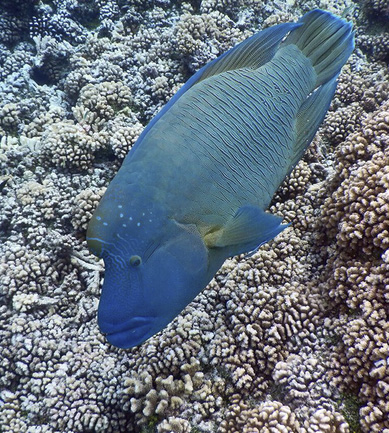Published in the Ocean Watch column, Honolulu Star-Advertiser © Susan Scott
February 29, 2016
At Hanauma Bay I often see and hear parrotfish chomping on living coral, their beaverlike teeth leaving distinct scars in the coral head’s skeleton. This can’t be good for the coral, yet natural populations of parrotfish are essential to healthy reefs.
To look into how this works, I found a 2014 study on the roles of parrotfish on tropical reefs. But as often happens when delving into the intricacies of marine systems, I got sidetracked by something unexpected: “The most corallivorous (coral eating) of all parrotfishes,” the researchers wrote, “is the bumphead wrasse.”
 The humphead wrasse is a friend of coral and eats crown-of-thorn starfish.
The humphead wrasse is a friend of coral and eats crown-of-thorn starfish.
©2016 Susan Scott
What? Are the terms “wrasse” and “parrotfish” interchangeable in Brazil and Australia, the authors’ home bases? No. The writers made a mistake in calling the coral-eating bumphead parrotfish a wrasse. But wrasses and parrotfish are so closely related, and regional common names vary so widely, it’s easy to get them mixed up.
The wrasse family has 450-some species, including one that grows 6 feet long called the humphead wrasse. The giant fish’s other names are Napoleon wrasse, Maori wrasse and Cheilinus undulatus.
The parrotfish family has about 100 species. The biggest at about 4 feet long is the bumphead parrotfish, or Bolbometopon muricatum.
Hawaii hosts 45 wrasses and nine parrotfishes but neither of the above giants.
The International Union for the Conservation of Nature lists the humphead wrasse as endangered and the bumphead parrotfish as vulnerable, because they’re slow-growing and overfished in most places. I’ve been lucky. I’ve seen the fish in French Polynesia, in Palau and at the Great Barrier Reef, but only in protected areas.
You can easily tell the fish apart by their lips: The humphead wrasse has large, plump lips. The bumphead parrotfish barely has lips at all, just skin stretched tight over jutting, fused white teeth.
But back to my original inquiry. Except for the bumphead parrotfish and a few other parrotfishes that eat live coral, most parrotfishes eat algae growing on dead coral rock. While feeding, the fish bite off pieces of old calcium carbonate skeleton, digest it into tiny pieces and expel it as sand.
Algae-eating parrotfishes, therefore, not only help keep algae growth in check, but also load reef floors with clean white sand. Even though the humphead wrasse doesn’t eat algae or manufacture sand, it’s still a friend of coral. The big fish eats, among other things, crown-of-thorn starfish.
A friend recently asked whether I ever run out of column topics. Never. Marine life is so interconnected that looking up a subject is like wandering a maze with a treat at each turn. And the subjects are virtually endless.